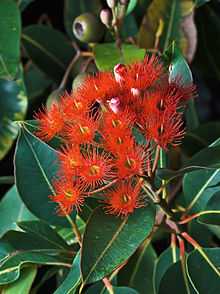Corymbia
| Corymbia | |
|---|---|
 | |
| Corymbia ficifolia, Flowers | |
| Scientific classification | |
| Kingdom: | Plantae |
| (unranked): | Angiosperms |
| (unranked): | Eudicots |
| (unranked): | Rosids |
| Order: | Myrtales |
| Family: | Myrtaceae |
| Genus: | Corymbia K.D.Hill & L.A.S.Johnson, 1995 |
| Type species | |
| Corymbia gummifera (Gaertner) K.D. Hill & L.A.S. Johnson | |
| Diversity | |
| about 113 species | |
Corymbia is a genus of about 113 species of tree that were classified as Eucalyptus species until the mid-1990s. It includes the bloodwoods, ghost gums and spotted gums. The bloodwoods had been recognised as a distinct group within the large and diverse Eucalyptus genus since 1867. Molecular research in the 1990s, however, showed that they, along with the rest of the Corymbia section, are more closely related to Angophora than to Eucalyptus, and are probably best regarded as a separate genus. All three genera - Angophora, Corymbia and Eucalyptus - are closely related, often difficult to tell apart, and are still commonly and correctly referred to as "eucalypts". Groups of naturalists and conservationists do not recognise the Corymbia genus and still categorise its species within Eucalyptus.[1]
Botanists Ken Hill and Lawrie Johnson were the first to define the genus Corymbia in 1995, identifying the bloodwoods, ghost gums and spotted gums as a group distinct from Eucalyptus.[2] Since then, there have been ongoing investigations into the relationships between the genera. Genetic analysis of ETS and ITS sequences of DNA in 2006 by Carlos Parra-O and colleagues of 67 taxa (47 of which were within Corymbia) yielded Corymbia and Angophora as each other's closest relatives, with the genus Eucalyptus as an earlier offshoot. The small genera Eucalyptopsis, Stockwellia and Allosyncarpia formed a clade which arose earlier still.[3] In 2009, Parra-O and colleagues added more taxa and published a combined analysis of nuclear rDNA (ETS + ITS) and morphological characters published to clarify relationships within the genus. This confirmed two main clades, which they defined as the subgenera Corymbia and Blakella.[4]
Species
Corymbias are readily distinguished as "gum trees" that form corymb inflorescences. A corymb has the appearance of a compound umbel, however it has irregularly lengthened pedicels that help form a flat-topped inflorescence.
The Angophora genus is a lot harder to distinguish from the Eucalyptus genus. The main distinguishing feature that separates the two, is that Angophoras have opposite leaf attachments at maturity and most eucalyptus species don't. However juvenile leaves of Eucalyptus are usually opposite and many species have opposite adult leaves.
Some of the better known corymbias are:
- Corymbia aparrerinja (Ghost Gum)
- Corymbia calophylla (Marri or Port Gregory Gum)
- Corymbia citriodora (Lemon-scented Gum). A tall, smooth-trunked tree native to central and northern Queensland and planted in many other areas, well known for the beauty of its white or light grey trunk and instantly recognisable by the strong lemon scent of its leaves.
- Corymbia eximia (Yellow Bloodwood)
- Corymbia ficifolia (Red Flowering Gum)
- Corymbia gummifera (Red bloodwood)
- Corymbia henryi (Large Leaved Spotted Gum)
- Corymbia maculata (Spotted Gum). Another popular garden tree.
- Corymbia opaca (Bloodwood). Native to Central Australia.
- Corymbia ptychocarpa (Swamp bloodwood). Native to the north of Australia, this species is a very popular garden plant.
-

Corymbia, capsules (Fruit)
-

Corymbia, flowers
-

Corymbia, capsules (Fruit)
References
- ↑ Brooker & Kleinig (2006) Field Guide to Eucalypts. 3rd ed.
- ↑ Hill, Ken D.; Johnson, L.A.S. (1995). "Systematic studies in the Eucalypts 7. A revision of the bloodwoods, genus Corymbia (Myrtaceae)". Telopea 6: 185–504.
- ↑ Parra-O., Carlos; Bayly, Michael; Udovicic, Frank; Ladiges, Pauline (2006). "ETS sequences support the monophyly of the eucalypt genus Corymbia (Myrtaceae)". Taxon 55 (3): 653–63. JSTOR 25065641.
- ↑ Parra-O., C.; Bayly, M. J.; Drinnan, A.; Udovicic, F.; Ladiges, P. (2009). "Phylogeny, major clades and infrageneric classification of Corymbia(Myrtaceae), based on nuclear ribosomal DNA and morphology". Australian Systematic Botany 22 (5): 384–399. doi:10.1071/SB09028.
External links
| Wikimedia Commons has media related to Corymbia. |